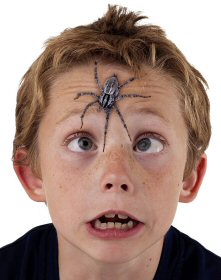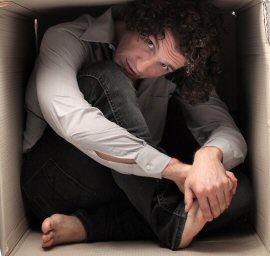Phobias: Understanding How They Develop and Treatments
Conquering Your Fears
While almost everyone has a fear or two that is considered normal (such as the
fear of snakes or spiders), others have fears that are so intense they can
become debilitating. Nevertheless, even the strongest fears or phobias can be
overcome with proper treatment and therapy.
The Difference between a Normal or Irrational Fear
|
Actually, this is a fake model swimming
pool below:

|
While normal fears enable us to take the proper actions to safeguard ourselves,
irrational fears or phobias turn a regular fear into an exaggerated threat.
Similar to natural occurring stressors and irrationally manifested stressors,
fears are categorized in a similar way where normal fears are good for us and
irrational fears can actually do harm to our well being. For example, while it’s
normal to be fearful of a large, snarling dog, the fear becomes phobic when
you’re even scared of dogs that are friendly and small.
Flying through turbulence can understandably make someone feel a bit
squeamish. However, when your fear of flying keeps you from taking business
trips or attending the wedding of a good friend, then you need to reassess your
behavior. The fear is becoming debilitating and dangerous, requiring immediate
attention from a psychotherapist or psychiatrist. Medication and or cognitive
therapy used in concert may be essential to returning the patient back to a
stable, healthy mental disposition. These behavioral disorders can become
dangerous and destructive leaving the patient alienated and withdrawn because of
their condition, which can lead to clinical depression and much more dangerous
emotional and mental disorders and diseases.
When Fears First Start to Surface
Fears first develop in childhood when children are upset and fearful of the
dark, demanding night lights and additional bed-time stories. The ever present
monster under the bed or in the closet wreaks havoc on young parents' patience
during the first few years of a child sleeping entirely on their own in their
own room and bed. Children can develop a fear of the dark as well as a dread of
such imaginary creatures as monsters or ghosts. As we get older, we may develop
fears related to natural disasters, injury, ailments, or performance at school
or in competitive sports. All these fears are normal and part of the
developmental process.
There are Four Primary Kinds of Fears
Generally, there are four main kinds of fears or phobias, each which are
represented as follows:
- Fears related to specific situations include such phobias as
claustrophobia (fear of enclosures) or aviophobia (fear of flying).
-
 Phobias related to animals, such as fears of dogs, snakes, or spiders. Phobias related to animals, such as fears of dogs, snakes, or spiders.
- Natural environmental fears or phobias, such as a fear of the dark or a
fear of thunder.
- Fears that are associated with blood or injections. Medical procedures
can cause people to squirm or even faint at the sight of a needle or blood.
Patients who are afraid of needles or blood will often faint on their way to
their car in the middle of the waiting room at their doctor's office up to a
half hour after any blood was drawn. The fear can be built up in the
patient's mind and even after the procedure that the patient was afraid of
is concluded, there is till a real risk of the patient fainting as a result
of mild shock and something similar to a panic attack. Since falling
abruptly can be dangerous where injuries as a mild as a few bruises all the
way up to broken bones can occur, many general practitioners make notes in
their “trouble” patients' charts so to ovoid any chances of a patient
inadvertently hurting themselves following a procedure that required some
blood to be drawn.
Types of Common Phobias
Some of the most common phobias include:
- Acrophobia (the fear of heights)
-
 Arachnophobia (the fear of spiders) Arachnophobia (the fear of spiders)
- Aviophobia (the fear of flying)
- Claustrophobia (the fear of enclosed spaces)
- Brontophobia (the fear of thunder)
- Ophidiophobia (the fear of snakes)
- Cynophobia (a fear of dogs)
- Scotophobia (a fear of the dark)
A Fear of the Dark: Not Just a Phobia of Childhood
Fear of the dark does not seem to be a fear only attributed to childhood as
it is referenced by a variety of names, including lygophobia, nyctophobia, and
myctophobia as well. Nyctohylophobia also defines fear of the dark, but the dark
associated with the woods or forest at night. Fear of the dark has a much more
broad scope when it comes to fears. There is a suggestion that being afraid of
the dark has a much deeper psychological meaning, where the person suffering
from this type of fear is really afraid of the unknown or events of the near
future.
A Fear of Long Words
Of course, the above listing is just a sampling of the hundreds of phobias
that are classified or known. There truly is a fear and classification for
nearly anything as human beings seem to have justified or rationalized their
fears over years of evolution and human development. Human being truly are
frightful animals and fear is a very dangerous emotion to the overall stability
of mankind. More specific phobias include such fears as
hippopotomonstrosesquippedaliophobia, which, ironically, is the fear of long
words. So, if you have an aversion to lengthily spelled words, you no doubt will
never know the name of your fear unless, of course, you are cured. People who
fear words altogether are known to be logophobic.
A Few More Examples of Unusual Phobias
Or, if you prefer to stand than sit, then you could be suffering from
kathisophobia (or the fear of sitting down). Monophobes fear being alone while
octophobes don’t like the number eight. Needless to say, it's probably a sure
bet that people who are octophobes are not professional ice skaters.
Symptomatology
Symptoms associated with a phobia include:
- Breathlessness or difficulty breathing
- Dizziness or lightheadedness
- Cold or hot flashes
- Chest pain or discomfort
- Racing heart
- Shaking or trembling
- Indigestion
When to Seek Professional Treatment
Sufferers may feel overwhelming panic and an inability to control their fear.
Professional treatment should be sought if the fear causes intense anxiety,
unmanageable anxiety, and has been recurrent for six months or more. If you know
the fear is unreasonable or you’re avoiding daily activities because of your
phobia then, make an appointment to speak with a therapist.
A psychologist who specializes in cognitive behavioral therapy (CBT) can help
you examine your fear and look at the triggers that cause you to become anxious
and feel fearful. In some cases, patients have overcome their fears through
hypnotherapy. Many times the anxiety will be managed with a light Benzodiazepine
tranquilizer, and managing the fear itself is tackled the best with cognitive
behavioral therapy.
The following video shows how a patient was cured from his fear of snakes:
Facing Your Fear Head On – Some Self-help Tips
Make a List of Activities Associated with Your Fear
As a form of self-help, you can also learn coping mechanisms in order to face
your fear. To begin the process, make a list of specific environmental
situations that are associated with your phobia. For example, if you’re scared
to fly, your list might include making flight reservations, packing your
luggage, driving to the airport, boarding the aircraft, or even watching
airplanes during take-off. Number the events in accordance with their level of
scariness. This will give you a list of triggers and with this list you will
begin to start managing your triggers instead of the fear itself. It is much
more efficient and effective when it comes to behavioral disorders and mental
illness to put together an effective treatment plan. Taking on a disease or
condition head on and in its entirety is not a healthy strategy. By putting
together a list of triggers formulated from the list of environmental factors
will be a valuable tool for patients to use to manage their fears and
surrounding conditions much more appropriately.
Going from the least scary activity to the most nerve-racking event, you can
gradually face each fear-related experience before checking it off your list.
Breathe Deeply
 It also helps to practice relaxation techniques to cope with unfounded fear
and stress. For example, if you feel anxious, breathe deeply and slowly, staying
focused on your breathing. Learn this technique to prevent episodes which cause
you to hyperventilate. It also helps to practice relaxation techniques to cope with unfounded fear
and stress. For example, if you feel anxious, breathe deeply and slowly, staying
focused on your breathing. Learn this technique to prevent episodes which cause
you to hyperventilate.
Get Rid of Your Self-defeating Thought Process
Look at your self-defeating thoughts in the eye as well. People with phobias
tend to exaggerate the threats associated with their fears and, at the same
time, shrink at the idea of doing anything about them. That’s because the
thoughts that are related to fear are typically illogical and unrealistic.
Therefore, fearful thoughts can turn into overgeneralizations or become
catastrophic in their effect. Ever hear of the term “stinking thinking”? It
means any thoughts or thought processes that lead to negative self-image, low
self-esteem, and any other self-defeating thoughts. To sum it up simply,
“stinking thinking” refers to beating yourself up with negative thoughts and
attitudes and should be avoided at all costs – especially when dealing with
mental disease or disorders. By feeding your brain negative thoughts all the
time you will eventually begin to believe them to be true. Sounds corny, but
positive thinking will lead to positive outcomes. Additionally a whole lot of
stress and negative emotional turmoil can be avoided completely by trying to
keep a positive attitude.
Ask Yourself the Following
To counteract such feelings, ask yourself a couple of questions:
- What can I do to resolve the situation related to my fear if something bad
should occur?
- Am I being logical about how I am feeling?
Take an Affirmative Stance
Also, respond to any negative thinking with positive affirmations. For
example, tell yourself:
- If a situation is making me nervous, I'll go into relax mode, so to speak.
I'll breathe deeply and focus on the my breaths until the nervousness passes.
- I’ve gone through this situation before and I’m still here – nothing
unpleasant resulted then. It won't happen now.
Face Your Fears
We can use our imagination to fuel our fears or use the same type of thinking
to overcome them. Look directly at your fears and you’ll eventually clear your
thoughts of any anxiety.
Diseases & Conditions
Top Lists:
Top 10 Most Common Genetic Disorders
Top 15 Most Disturbing Skin Conditions
10 Unusual Phobias
Informational:
Diverticular Disease and Diverticulitis
What is Turner Syndrome and Why Does it Affect Only Females?
Alice in Wonderland Syndrome and How to Treat the Symptoms
Herniated Disc: Symptoms and Treatments
Pinch Nerve: The Cause of Remote Pain
Dealing With a Child Who Has a Fever
How Unhealthy Diet Could Trigger Inflammatory Arthritis
Phobias: Understanding How They Develop and Treatments
Depression Facts, Symptoms & Treatment
Earaches - Causes and Treatments
Symptoms of Borderline Personality Disorder and How to Deal with It
Seasonal Affective Disorder: Does Light Therapy Help?
What Really Causes Dandruff and How Can You Treat the Symptoms
Treating Plantar Fasciitis or Heel and Arch Pain
Symptoms and Treatments of Aplastic Anemia
Using Sclerotherapy to Get Rid of Varicose Veins
Are the Side Effects of HGH Supplements Worth It?
ADD/ADHD Symptoms and Treatment
What are the Options for Hair Loss Treatments
Options for Frontal Hair Loss Treatment |